Fritz Weidner (architect)
| Ernst Friedrich Wilhelm | |
|---|---|
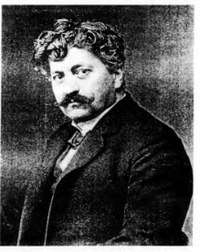 Picture of Fritz Weidner | |
| Born |
March 13, 1863 Nowe Drezdenko, Kingdom of Prussia |
| Died |
November 10, 1950 (aged 87) Potsdam, East Germany |
| Nationality | Prussian |
| Occupation | architect |
| Spouse(s) | Alice Weidner née Goodson (1867-1957) |
| Children | Charlotte, Erna, Hans, Margarete, Walter |
| Parent(s) | Antoni Marie Augusta née Herold and Julius Weidner |
Fritz Weidner (1863–1950) was an important designer and builder in Bydgoszcz, at the time of Prussian domination. A vast majority of his works is associated with the city. He is one among many architects and builders who gave a characteristic shape to the town at the turn of the 19th and 20th centuries, dominated by eclectic buildings with various styles, including Art Nouveau or Modernism.
Life
Ernst Friedrich Wilhelm was born on March 13, 1863, in Nowe Drezdenko (German: Vordamm). His father Julius, from Bielefeld, was the head of the railway station. His mother Antoni Marie Augusta née Herold was the daughter of Friedrich Herold, a local masonry master, also mayor of Drezdenko.[1] The young Fritz spent his childhood and early youth in a family home. He graduated from the local public school and later obtained the builder qualification by passing the masonry exam. He soon got the rights to work as a manager.
At the beginning of the 1880s, he moved to Berlin and lived there with his brother Ernst, also a construction technician. According to family letters,[1] he had been studying architecture and painting at the Berlin Academy of Arts for several semesters. This reduced academic education was not enough to obtain the title of architect, therefore, Fritz Weidner presumably followed courses in other universities of the German capital. During these sessions, he met his future wife, Alice Goodson, an Englishwoman.
Alice was the daughter of Thomas Goodson and Emma (née Wats). Thomas, London-born citizen, had been working in Berlin since 1859, as a city sanitary engineer. Alice was born in Berlin on May 20, 1867.[1] Later he founded the company Thomas Goodson-Tiefbaufirma, offering engineering services in the field of underground constructions and plumbing installations. Fritz Weidner was rapidly employed at the Goodson company and there he took his first steps as a building designer.
Working in Bromberg
In 1895, he arrived alone in Bydgoszcz (German: Bromberg), where he worked as a manager of the local branch of the Goodson company which contract was to supervise the construction of city sewerage network.[2] Three years later, thanks to the thriving economic situation in Bydgoszcz offering a profusion of career opportunities, he decided to settle in the city.
He brought his family and set up his own architecture office, while keeping his cooperation with his father-in-law. He was particularly active from 1896 to 1914. His studio took part in 90 investments: 25 were projects for new front houses, while the other works were related to rebuilding residential houses or erecting smaller constructions such as utility rooms (stables, garages, warehouses), fencing and parking lots. Most of the realizations were commissioned by private investors, mainly city rentiers, manufacturers, merchants or artisans.
His works are mainly concentrated in:
- Gdańska Street (9 edifices);
- Cieszkowskiego Street;
- Śniadeckich Street;
- Dworcowa Street;
- 20 January 1920 Street.
Three buildings were the result of housing cooperative funding (German: Wohnungsverein). They are located at Cieszkowskiego Street 13/14, Staszica Street 3/5 and Kołłątaja street 1. The latter was awarded as the most beautiful new building in 1912, in a competition organized by city authorities (together with Rudolf Kern's house at 20 January 1920 Street).[3]
Weidner was at the origin of the first building in Bydgoszcz using reinforced concrete: designed by Berlin architect Otto Walther, it stands today at Gdańska Street 15. His work also includes two large edifices in downtown district: the Mix Ernst tenement at Gdańska Street 10 and the Brandt Department Store at Theatre square 4, today the local seat of Bank Pekao.
Fritz Weidner, at the beginning of the 20th century, turned to Landhaus style, evoking German mansions. He directed the creation of an ensemble of single-family houses in Bielawy, a suburban commune of Bydgoszcz. He also became involved in applying the Garden city movement to Bydgoszcz urban planning.
Numerous deficiencies, such as building out of the limits, starting construction works without the reception of the raw building framework, not sticking to the initial blueprint, caused the city representatives in charge of construction policy to submit in December 1910, a request to the mayor to deprive Weidner of his professional rights to practice. However, archived records on the case do not make it clear whether the threat was considered positively; the architect was probably only admonished and a more intensified control of his work was applied.[1]
Other activities
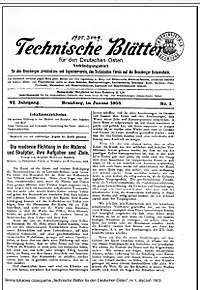
In addition to his professional activity, Fritz Weidner had a passion for journalism, especially to share new trends in art and architecture. In that sense, he was considered in Bydgoszcz by his distinguished ambition to give a meaning to his artistic mission. He put a lot of effort into studying and disseminating knowledge about the latest trends in architecture and fine arts. His time witnessed a period of great changes in European architecture, in particular in the German Empire. These changes were the portents of a radical shift between traditional style and new ones, i.e. Art Nouveau and early modernism. Weidner, knowledgeable of these significant changes, clearly followed new artistic grounds.
He expressed his views in articles published in the journal Technische Blätter für den Deutschen Osten published by the Society of Technicians (German: Technisches Verein) created in 1857, subsumed into the German Society of Arts and Sciences in Bydgoszcz. This association focused mostly on local construction entrepreneurs, architects, industrialists, engineering staff and craftsmen from various industries. Among his several writings (more than ten from 1903 to 1911), he wrote about Style, stylish, no style - from classic style to Secession, Böcklin and his art or Modern trends in painting and sculpture, their tasks and aims.[4]
Weidner was an active member of the union's trade board, where he regularly gave lectures and readings about technical problems related to building design (e.g. lighting, water and sewage networks) or issues related to the theory of art and the concept of new artistic trends. From 1903 to 1906, he was the vice-chairman of this board. In 1907 he participated in publishing a book, Industry and Commerce in Bromberg (German: Industrie und Gewerbe in Bromberg) to celebrate the 50th anniversary of the Society of Technicians.
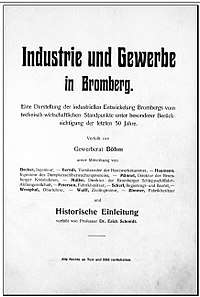
Style
Fritz Weidner's artistic style has evolved from Eclecticism to Art Nouveau, through three stages.
When he arrived in Bydgoszcz, his works were characterized by eclectic forms, with many Neo-Baroque decorative elements.
The second step of his stylistic maturation begun in 1897, with noticeable move towards Historicism where one can perceive a freedom of the planning, a lack of facade symmetry, as well as an abandonment of the stucco decoration, in favor of a decorative arrangement of different architectural elements (e.g. window shapes, loggias topped with arcades, bay windows, balconies).
Finally, in 1901, Weidner's work entered an Art Nouveau architectural phase, where he multiplied the use of various decorative motifs, playing with asymmetry on the frontages of his projects. Weidner's features related to Art Nouveau are mainly referring to the Viennese and German Secession, with a restrained, geometric approach, using organic motifs to a little extent, unlike what one can find in western countries Art Nouveau edifices.
He wrote in one of his articles:[4] "A style is never used, it stood up and did not arise from the momentary mood of the artist or even a larger group of artists, but always develops logically, each time from specific temporal-spatial relations, each time as a result from the way of life of certain people, from the technical possibilities and material. That's why styles too need to change and develop further as people's lives (...)"
Quotation an other article:[4] "There is nothing in art that is right or wrong. The truth is only and only on the conviction of artist's feelings, artist's approach. Art is no knowledge. The artist creates freely, by himself, with his sensation, his fantasy. If he creates according to established rules (...), he ceases to be an artist, he becomes a craftsman (...)"
Eventually, after 1905, he developed some liking for modernism, where stucco and basic decorative elements were reduced to a minimum on a facade.
Fritz Weidner was appreciated as an architect having a vision and the aesthetic values of his buildings are still appreciated today.
Life after 1914
After the outbreak of World War I, Fritz Weidner volunteered for military service. Due to his age, he was not admitted to active service and was sent to the Reichsmarine, serving as an architect: he was stationed in the Flanders to rebuild war damaged buildings on the coast. He then moved to Ełk and Giżycko, which suffered heavy destruction during the war in East Prussia.
In 1920, he returned to Bydgoszcz, decided to live in the city despite the exodus of the German population, linked to the return of Bydgoszcz to the re-created Polish territory. Albeit his positive expectations, the unstable economic situation combined with the outflow of German capital was not favourable for city construction investments.
In 1937, he left Bydgoszcz with his wife and settled in Hamburg. Initially, they lived with their older son Hans, but moved in 1939 to their own flat. During World War II, Fritz and Alice moved to their daughter's house, Margarete Bublitz, in Wysoka, near Piła.[1] Thanks to this, they avoided the tragic fate of many inhabitants during the allied air raids on July 24–30, 1943, when their Hamburg apartment was flattened.
In January 1945, Fritz and his wife escaped from the approaching soviet army invading eastern Germany. They travelled by harsh winter days (-18 °C), from Drawsko Pomorskie to Potsdam, where they survived a last great air raid. In Potsdam, on September 25, 1950, the couple celebrated their diamond wedding anniversary. Fritz Weidner died on October 10, 1950 and was buried in Teltow district cemetery.
Personal life
Fritz Weidner married in September 25, 1890, Englishwoman Alice Jessie Goodson. They had five children: Charlotte, Erna, Hans, Margarete and Walter. In Bydgoszcz, the family lived at Dworcowa Street 73, in the flat which initially belonged to Friedrich Herold, grandfather of Fritz Weidner. Alice Weidner died on December 2, 1957, in Lengerich, Westphalia.[1]
Works in Bydgoszcz
| Year | Edifice | Remarks | Picture |
| January 1895 | Villa Fritz Heroldt | Located at Gdańska Street 119. Earliest surviving project realized by Fritz Weidner. | 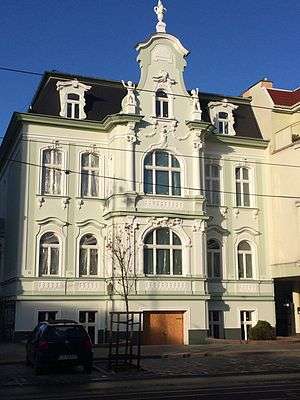 |
| September 1895 | Tenement House | Located at Dworcowa Street 73, Fritz Weidner lived there with his family. | 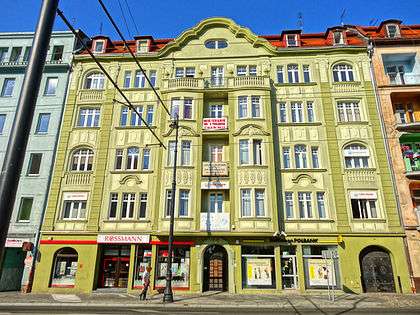 |
| October 1895 | Hermann Dyck Villa | Located at Królowej Jadwigi Street 25 | |
| August 1897 | Carl Bradtke tenement | Located at Gdańska Street 91. |  |
| 1897 | Thomas Frankowski Tenement | Located at Gdańska Street 28. | |
| August 1897 | Tenement house | Located at Pomorska Street 35. | 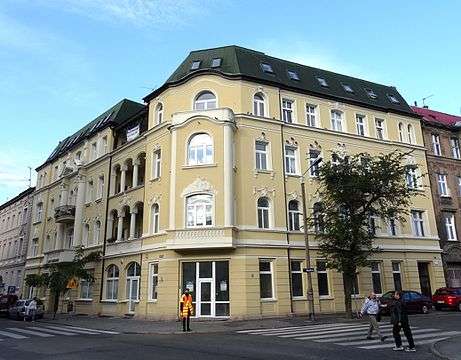 |
| September 1898 | Vincent Krause's house | Located at Cieszkowskiego Street 22. Vincent Krause was a wealthy local craftsman.[5] |  |
| September 1898 | Ernst Bartsch tenement | Located at Gdańska Street 79. |  |
| August 1901 | Carl Bartz House | Located at Marchinkowskiego street 14, it houses today the city cultural center (Polish: Miejskie Centrum Kultury). |  |
| July 1902 | Tenement House | Located at Cieszkowskiego Street 13/15. Order from a housing cooperative (German: Wohnungsverein). |  |
| November 1902 | Carl Mauwe Tenement | Located at Śniadeckich Street 29. Carl Mauwe was a city photograph. | 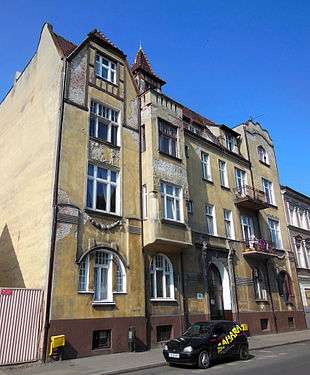 |
| February 1903 | Richard Schrammke Tenement | Located at Wileńska Street 6. |  |
| Year | Edifice | Remarks | Picture |
| September 1903 | Carl Ruckenschuch Tenement | Located at Plac Wolności 3. | |
| October 1903 | Tenement Houses | Located at Staszica Street 3/5. Order from a housing cooperative (German: Wohnungsverein). | 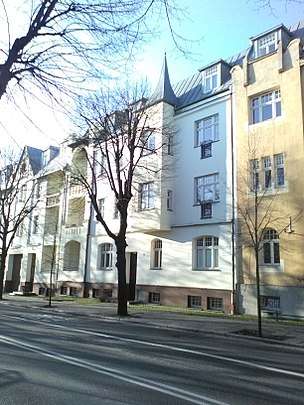 |
| May 1905 | Max Rosenthal Tenement | Located at Gdańska Street 42. | 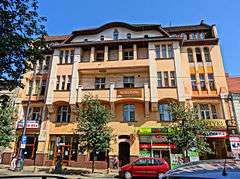 |
| July 1905 and June 1913 | Mix Tenement | Located at Gdańska Street 10. Arno Ernst Mix was a soap manufacturer. | 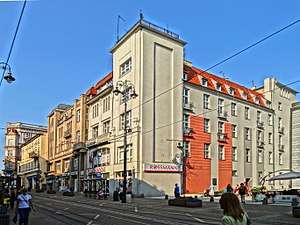 |
| August 1905 | Moritz Ephraim tenement | Located at Śniadeckich Street 2. | 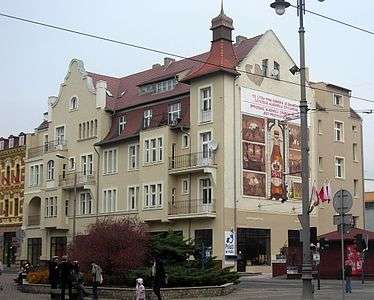 |
| October 1906 | Walther Minge tenement | Located at Gdańska Street 34, it represents the scenic trend.[2] |  |
| October 1907 | Oskar Unverferth House | Located at 20 Stycznia 1920 Street 3. Oskar Unverferth ran a furniture factory.[6] | 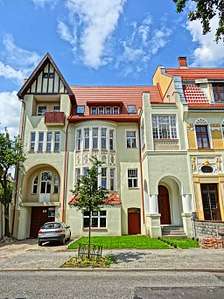 |
| November 1909 | Otto Pfefferkorn tenement | Located at Dworcowa Street 12. Otto Pfefferkorn, a furniture factory manager, used the ground floor as a show-room. | 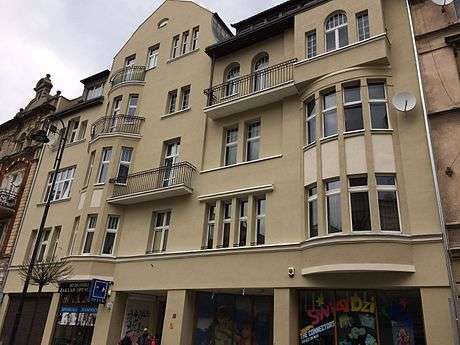 |
| December 1909 | Tenement House | Located at Kołłątaja street 1. Order from a housing cooperative (German: Wohnungsverein). |  |
| March 1910 | Tenement House | Located at 20 Stycznia 1920 Street 19, the commissioner was Richard Schrammke, also owner at Wileńska Street 6. | 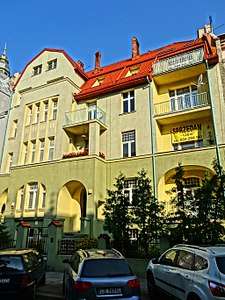 |
| February 1911 | Brandt Department Store | Located at Theatre square 4, the commissionner was Max Zweininger, owner of a famous hat manufactory who was living at Focha street 2 |  |
See also
| Wikimedia Commons has media related to Fritz Weidner. |
References
- 1 2 3 4 5 6 Jastrzębska-Puzowska, Iwona (2000). Poglądy artystyczne i twórczość bydgoskiego architekta Fritza Weidnera cz. II. Materiały do Dziejów Kultury i Sztuki Bydgoszczy i Regionu. zeszyt 5. Bydgoszcz: Pracownia Dokumentacji i Popularyzacji Zabytków Wojewódzkiego Ośrodka Kultury w Bydgoszczy. pp. 37–47.
- 1 2 "Around the City Centre". visitbydgoszcz.pl. visitbydgoszcz.pl. 2018. Retrieved 23 April 2018.
- ↑ Dobosz, Krystian (4 May 2017). "[Cieszkowskiego] Pięknieje jedna z najładniejszych ulic w Bydgoszczy". bwb.info.pl. bwb.info.pl. Retrieved 23 April 2018.
- 1 2 3 Jastrzębska-Puzowska, Iwona (1998). Poglądy artystyczne i twórczość bydgoskiego architekta Fritza Weidnera cz. I. Materiały do Dziejów Kultury i Sztuki Bydgoszczy i Regionu. zeszyt 3. Bydgoszcz: Pracownia Dokumentacji i Popularyzacji Zabytków Wojewódzkiego Ośrodka Kultury w Bydgoszczy. pp. 44–55.
- ↑ cdn. "Secesyjna Bydgoszcz". muzeumsecesji.pl. muzeumsecesji.pl. Retrieved 23 April 2018.
- ↑ "HISTORIA KAMIENICY PRZY UL. 20 STYCZNIA 1920R. NR 3". willaparkowa.com. willaparkowa.com. 2012. Retrieved 23 April 2018.
Bibliography
- (in Polish) Błażejewski Stanisław, Kutta Janusz, Romaniuk Marek. Bydgoski Słownik Biograficzny. Tom VII. Bydgoszcz: Bydgoszcz Kujawsko-Pomorskie Tow. Kulturalne. pp. 115, 118. ISBN 8385327703.
- (in Polish) Jastrzębska-Puzowska, Iwona (1998). Poglądy artystyczne i twórczość bydgoskiego architekta Fritza Weidnera cz. I. Materiały do Dziejów Kultury i Sztuki Bydgoszczy i Regionu. zeszyt 3. Bydgoszcz: Pracownia Dokumentacji i Popularyzacji Zabytków Wojewódzkiego Ośrodka Kultury w Bydgoszczy. p. 44.
- (in Polish) Jastrzębska-Puzowska, Iwona (2000). Poglądy artystyczne i twórczość bydgoskiego architekta Fritza Weidnera cz. II. Materiały do Dziejów Kultury i Sztuki Bydgoszczy i Regionu. zeszyt 5. Bydgoszcz: Pracownia Dokumentacji i Popularyzacji Zabytków Wojewódzkiego Ośrodka Kultury w Bydgoszczy. pp. 37–47.
- (in German) Iwona Jastrzębska-Puzowska (Bydgoszcz/Bromberg) - Der Bromberger Architekt Fritz Weidner – Kunstauffassung und Werk